Shortly after the Scottish poet W.S. Graham met Roger Hilton in St Ives in the autumn of 1956, he wrote the poem ‘Hilton Abstract’. This was the first of several poems he would address to his painter friends over the coming years, most famously the elegies ‘The Thermal Stair’ (for Peter Lanyon), ‘Lines on Roger Hilton’s Watch’, and ‘Dear Bryan Wynter’. Indeed, no story of painting in St Ives is complete without Graham, who was interlocutor and antagonist, comrade and rival, to artists there from when he first met Ben Nicholson and Barbara Hepworth in 1943 until his death in 1986. Graham was also the host for John Minton, and the ‘two Roberts’, Colquhoun and MacBryde, when they visited St Ives in the mid and late 1940s, thus becoming a point of contact between neo-Romantic and modernist currents in mid-century British art – just as his poetic oeuvre stands at the intersection of the neo-Romanticism of Dylan Thomas and the modernism of T.S. Eliot and Wallace Stevens.
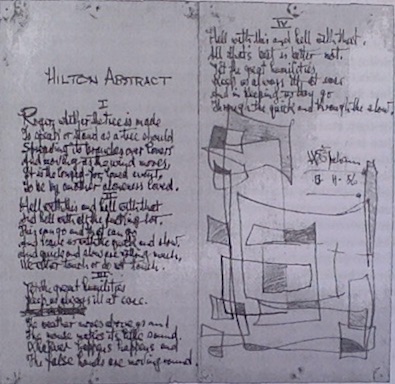
‘Hilton Abstract’ (1956) by W.S. Graham, featuring a geometric pattern at the end of the manuscript. Published in The Nightfisherman, Michael and Margaret Snow (eds.), Manchester: Carcanet, 1999. © The Estate of W.S. Graham
‘Hilton Abstract’ was, before it was a published poem, a gift of friendship. It responds both to Hilton the abstract painter, and Hilton the man, and veers continually between the two. During my research into Graham’s writings, I was able to see the fair copy he made as a gift. The poem is written in his inimitable calligraphic hand (Graham had been apprenticed as a draughtsman in the Greenock shipyards in his teens), but what grabs the eye is an intricate sketch at the bottom of the manuscript. Made up of quasi-geometrical patterns, more constructivist than tachiste in its immediate visual reference points, it is markedly unlike Hilton’s own work. To Hilton’s abstract, Graham appends his own. As a result, one sees a dialogue not just between painter and poet, but between two different visual sensibilities.
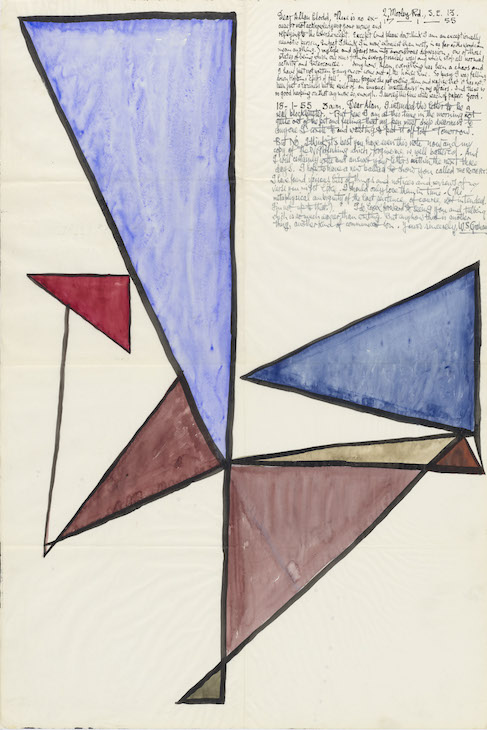
Letter to Alan Clodd from W.S. Graham, decorated with overlapping triangles, early 1955. Image courtesy of the National Library of Scotland; © The Estate of W.S. Graham
The longer I spent visiting archives and private collections, the more such designs I encountered: for instance, the overlapping triangles from a letter to Alan Clodd, friend and patron, from early 1955, in which the blocks of watercolour on tracing paper create a kind of stained glass effect. Graham was a key member of artistic communities – in Glasgow, London, St Ives – and his poems continually reflected on the personal and technical demands of art. Yet I found myself asking: should Graham be considered an artist in his own right? This question has resulted in ‘Voice and Vision: The Poetry and Art of W.S. Graham’, an upcoming exhibition that I have curated at Pier Arts Centre, Orkney (22 September–10 November).
It is not simply that Graham was not counted an artist in his lifetime, did not participate in an art market, or exhibit in galleries. Graham’s visual works gnaw at the distinction between art and non-art. His manuscripts, notebooks, and letters overflow with abstracts, drawings of ‘Etruscan’ heads, as he called them, and images of tin mines and fishing boats, which populate both the landscape of West Cornwall and Graham’s poetic imaginary. The most extraordinary of these, which we reproduce in full, is a notebook in which he superimposed his own drawings and writings over the pages of a science textbook he’d picked up in a secondhand bookshop: Artificial Limbs: For Use After Amputation and Congenital Deficiencies by F.G. Ernst (1923). This genre-defying production predates Tom Philips’s A Humument by over a decade.
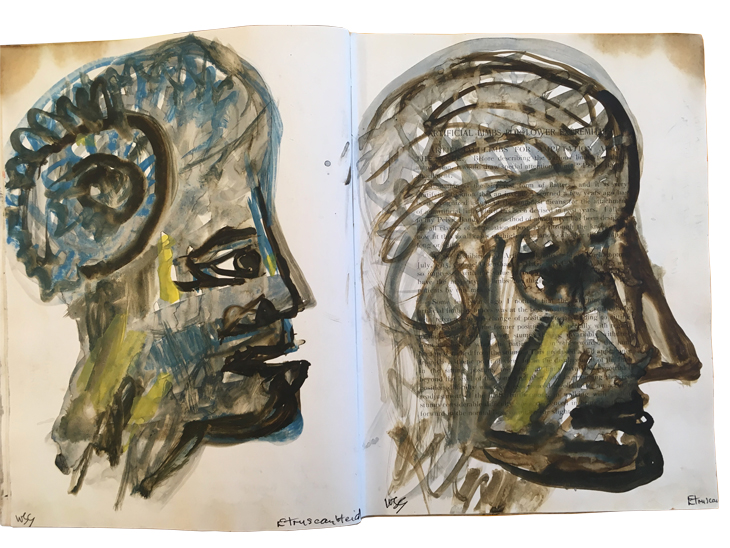
Drawings of an Etruscan head by W.S. Graham over the pages of ‘Artificial Limbs: For Use After Amputation and Congenital Deficiencies’ by F.G. Ernst (1923). Image courtesy of the Special Collections and University Archives, McPherson Library, University of Victoria, BC; © The Estate of W.S. Graham
Given that visual and poetic sketches are juxtaposed in Graham’s work, it is tempting to consider his drawings to be simply doodles, a by-product of his creative process, or testament to a creative energy which found expression on whatever materials came to hand – from scrap paper and torn-off hardback book covers to earthenware slabs. In a letter dated 1949, he tells the artist Sven Berlin that he was ‘doing a few drawings’ while developing ideas and experiments for his poetry; he called this ‘automatic drawing’, an adoption from the automatic writing practices he had long employed to develop material for his poetry. But this risks downplaying the singularity of Graham’s visual output. Indeed, Graham achieves a distinctive aesthetic vernacular – some of his drawings from the 1960s seem to anticipate, perhaps even influence, Hilton’s Night Letters. It is for this reason that we were keen to bring Graham’s visual works together and display them on gallery walls, alongside the works of those painters and sculptors who had formed his major community – Hilton, Lanyon, Nicholson, John Wells, Alan Lowndes, and Wilhelmina Barns-Graham.
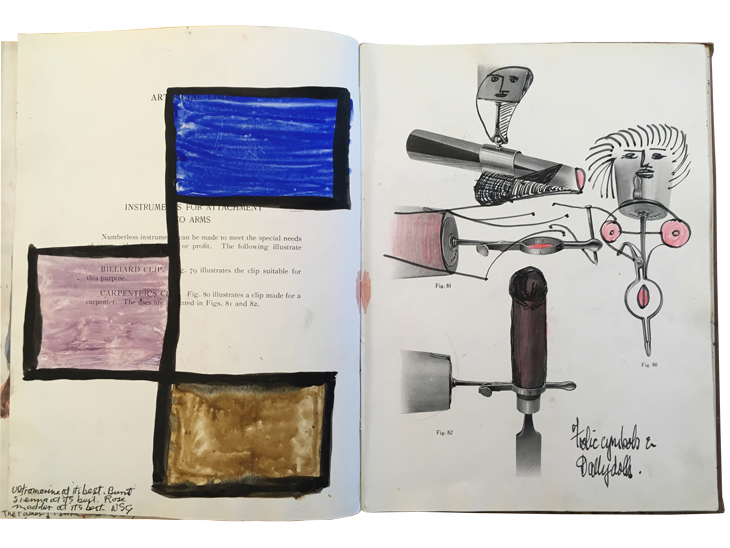
Drawings by W.S. Graham over the pages of ‘Artificial Limbs: For Use After Amputation and Congenital Deficiencies’ by F.G. Ernst (1923). Image courtesy of the Special Collections and University Archives, McPherson Library, University of Victoria, BC; © The Estate of W.S. Graham
The exhibition is also indebted to those friends of Graham’s who preserved sketches, manuscripts, occasional works, postcards. Graham himself lived most of his life in poverty and neglect, and many friends supported him through informal patronage, paying him for drawings and manuscripts which they would then archive for posterity. But much has been lost. During my research I’ve heard stories of a painting on glass being shattered during a house move, of manuscripts lost in the post en route to a public archive, or being put in a bonfire by mistake. The precariousness of the oeuvre gives additional poignancy to the works that have survived, and inspires the question: what else is out there, and where?
‘Voice and Vision: The Poetry and Art of W.S. Graham’ is at the Pier Arts Centre, Orkney from 22 September–10 November.
Unlimited access from just $16 every 3 months
Subscribe to get unlimited and exclusive access to the top art stories, interviews and exhibition reviews.


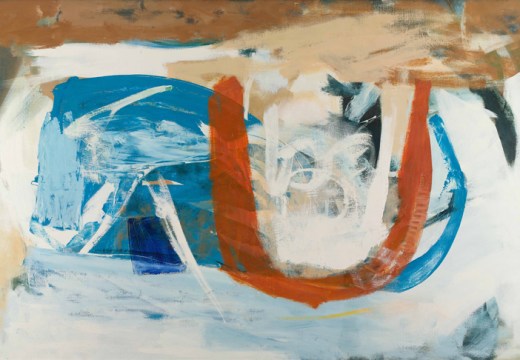
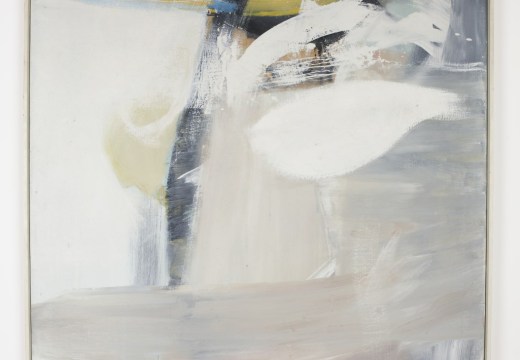
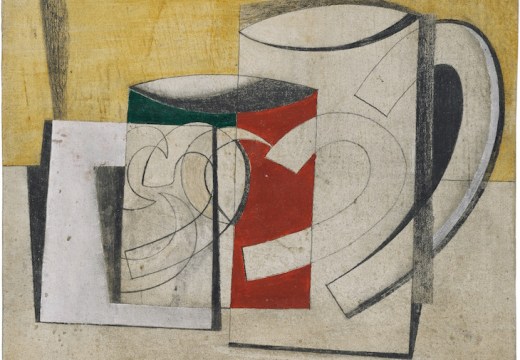









![Masterpiece [Re]discovery 2022. Photo: Ben Fisher Photography, courtesy of Masterpiece London](http://www.apollo-magazine.com/wp-content/uploads/2022/07/MPL2022_4263.jpg)
It’s time for the government of London to return to its rightful home